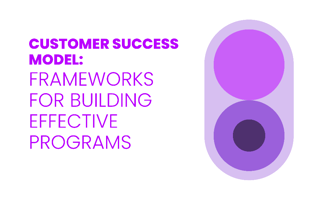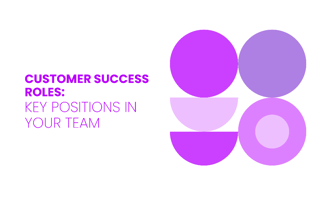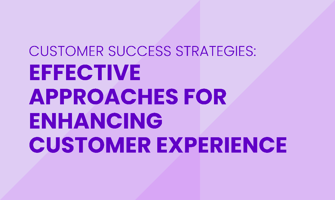Many SaaS companies lose out on big profits from existing customers. They focus too much on new...
Customer Success Manager Job Description: Roles, Responsibilities, and Skills
A Customer Success Manager (CSM) helps companies keep their customers happy and ensures they use products well. They solve issues before they become problems. They also help customers see the value in what they buy.
Good CSMs need to be organized, empathetic, and great at building relationships. They make sure customers stay with the company. They also find new ways to grow the business together.
Let's explore what it takes to be a CSM!
Overview of a Customer Success Manager
A Customer Success Manager works to keep customers happy and help them continue using the company's products.
They:
Make sure clients reach their goals with the products
Build strong relationships with customers using good communication and account management
In SaaS, they:
Focus on onboarding and training customers
Ensure the product is easy to use and customers have a good experience
They:
Support customers by observing usage patterns and suggesting improvements
Aim to improve satisfaction scores
A CSM collaborates closely with sales and internal teams to:
Increase account growth and renewals
Highlight the benefits for better returns on investment
They:
Manage the customer journey
Focus on customer retention and relationship marketing
Their role includes:
Promoting the brand
Helping with product education
Contributing to contract solutions
Through showing business value and using customer success guides, CSMs build trust and ensure the company's growth and customer happiness.
Core Responsibilities of a Customer Success Manager
Onboarding New Customers
A Customer Success Manager follows several steps to ensure new customers onboard smoothly.
They use strong communication skills to define customer expectations and goals.
This helps create a personalized onboarding plan tailored to the customer’s needs.
A CSM collaborates with internal teams like sales and technical support to gather all necessary information about the customer’s account and business value.
Tools such as customer success playbooks and contract logix solutions guide the process, while automation features in SaaS products help track user journeys, in-app behavior, and product adoption.
They conduct customer training sessions and product education to enhance customer experience and product enjoyment.
With regular check-ins and NPS surveys, they monitor customer satisfaction and retention, aiming for high renewal rates.
The main goal is to ensure new customers quickly see the return on investment, leading to account expansion and long-lasting customer success.
Building Strong Kundenbeziehungen
Customer Success Managers have many ways to build and improve customer relationships. They focus on onboarding and product education to help customers see the value of SaaS products quickly.
Their job includes account management and customer training. These tasks help improve customer satisfaction and retention. Good communication skills are needed to understand customer needs. This ensures their expectations are met and they get a high return on investment.
Regular communication and feedback through NPS surveys and tracking in-app behavior help keep strong customer relationships. Customer success teams work closely with internal teams, like sales, to find account expansion opportunities and provide support.
Trust is built through consistent customer service and technical support, making the customer experience better. Responsibilities also include creating a customer success playbook to guide the user journey and encourage product use.
Managing people well in hiring, training, and mentoring is key for a team's efficiency. By focusing on career development and understanding the customer lifecycle, Customer Success Managers can drive renewals and improve renewal rates, fostering strong customer relationships.
Boosting Customer Engagement
A Customer Success Manager can use data analytics to understand in-app behavior. This helps improve customer engagement by tailoring support and product adoption strategies.
For example, by analyzing user journey data, the manager can better meet customer expectations.
Successful strategies include:
Consistent communication skills
Proactive onboarding
Customer training
Using NPS surveys
These help build trust and stronger customer relationships.
Personalization techniques, such as automated messages based on customer actions, can increase satisfaction and retention.
Effective customer success teams should focus on account management and product education. This helps users see business value and return on investment.
Close collaboration with sales and internal teams enhances the overall customer experience and brand image, supporting the full customer lifecycle.
Responsibilities in the job include:
Managing onboarding
Providing technical support
Customer service
Continuous mentoring
These tasks boost hiring, training, career development, and can lead to a competitive salary range.
Customer success playbooks are useful tools that detail steps to improve customer satisfaction. They guide managers in delivering exceptional customer service and support.
Essential Skills for a Customer Success Manager
Communication Skills
A customer success manager must share information about SaaS products in a way customers can easily understand.
They use simple language for onboarding sessions and guides. This helps explain how features benefit the business.
CSMs adjust their communication style to fit different customer needs. Some customers want detailed explanations, while others prefer short summaries.
Good communication skills include active listening. CSMs notice user concerns through NPS surveys or in-app behavior. They then respond thoughtfully.
CSMs work with internal teams like sales and technical support. This helps improve the user journey and customer experience.
They support customers through product education and training. This ensures higher product adoption and satisfaction.
CSMs handle tasks like account management, contract renewals, and preventing customer churn. These tasks help boost customer retention.
Good communicators use tools like customer success playbooks and automation. These tools help track customer relationships, satisfaction, and business results.
Finally, mentoring and training within customer success teams build trust and improve workflow.
Analytical Thinking
A Customer Success Manager handles complex problems by breaking them into smaller, manageable parts. They use analytical thinking to meet customer needs and maximize benefits.
CSMs gather data from:
NPS surveys
In-app behavior
Customer feedback
They use this data to make informed decisions. They monitor user journeys and product adoption rates to improve customer satisfaction.
By analyzing customer service and support interactions, they spot potential issues and opportunities for account expansion. They work closely with internal teams like sales and technical support to solve problems efficiently.
CSMs use effective communication and a strong understanding of SaaS products to retain customers and build lasting relationships. Their responsibilities include:
Onboarding
Product education
Offering proactive solutions
These tasks are outlined in the customer success playbook. They focus on meeting customer expectations and ensuring a good return on investment to enhance the overall experience.
The role also involves people management. This includes hiring, training, and mentoring to ensure the success of customer success teams.
Problem-Solving Aptitude
A Customer Success Manager's problem-solving skill is shown by how they identify issues customers face.
They use tools like NPS surveys and analyze in-app behavior to find problems. For example, a CSM might see through automated tracking that a customer isn’t using a feature often. They reach out for product education and training to help improve usage and satisfaction.
When there are multiple problems, they use a customer success playbook. They prioritize based on business value and customer needs.
They balance onboarding new clients with solving technical support issues for existing ones. Communication skills are important. They work with teams like sales and account management to meet all customer needs.
Good problem-solving leads to better customer experiences. This improves customer retention and trust. It also leads to successful renewals and higher renewal rates. This enhances the overall value and return on investment for both the customer and the brand.
Requirements for Mid-Level and Upper-Level Customer Success Managers
Mid-Level Requirements
Candidates for mid-level roles in Customer Success Management should have strong experience in customer success, preferably in the SaaS industry.
They need to show they have worked in customer retention, account management, and driving customer satisfaction.
Good communication skills are important because they work with internal teams like sales and support.
They need to manage the customer journey and ensure a good customer experience.
Skills needed include onboarding, product education, and customer training.
Mid-level CSMs should know how to use tools like automation for customer education and NPS surveys to measure satisfaction and loyalty.
They are measured by metrics like customer retention rates, account expansion, and contract renewals.
This differs from entry-level roles, which focus on basic customer service and initial onboarding.
Mid-level CSMs must manage and improve the customer success playbook and track in-app behavior.
They should ensure customers see the business value and return on investment from the SaaS products.
They also handle people management, including hiring, training, mentoring, and career development.
This is part of guiding customer success teams toward better outcomes.
Customer Success Manager Job Description Template
A Customer Success Manager has many responsibilities.
Key tasks include:
Customer retention
Building strong customer relationships
Ensuring customer satisfaction
They manage onboarding processes and drive account expansion. They also make sure customer expectations are met. Other duties include:
Conducting NPS surveys
Tracking in-app behavior
Guiding customer success teams
Communication is important for product education and customer training sessions. CSMs should support internal teams, improve the customer experience, and increase product adoption. They must handle technical support and use tools like Contract Logix for customer service.
Important skills and qualifications include:
Strong communication
Empathy
Leadership
Sales and account management proficiency
Experience with SaaS products and a bachelor's degree are required. CSMs also manage renewals and renewal rates. They oversee people management, hiring, training, and mentoring within their teams. This role helps build the brand and provides value, ensuring a high return on investment for customers.
Importance of Customer Feedback and User Insights
Gathering customer feedback helps a manager understand how well a product meets customer expectations. It also helps identify areas for improvement.
Customer feedback can lead to a better user experience and increased product adoption. For instance, if feedback shows a difficult onboarding process, the team can refine it based on user insights. This adjustment ensures customer satisfaction and better product education.
By collecting and analyzing feedback, businesses can track NPS surveys, evaluate in-app behavior, and monitor customer retention rates. It also helps in offering technical support, boosting the overall customer experience.
Good communication skills are necessary to manage customer relationships. These skills ensure feedback turns into actionable steps. Insights can also guide marketing efforts and influence brand image. This aligns with sales team goals for customer success playbooks.
Being responsive to feedback in SaaS teams promotes account expansion and renewals. It also helps with better contract solutions. This increases return on investment and supports career growth in customer success roles.
By constantly collecting and analyzing feedback, businesses meet customer expectations. This leads to benefits like higher renewal rates and effective account management.
Industry Examples: SaaS Customer Success Managers
Successful SaaS Customer Success Managers use effective onboarding strategies to welcome new customers.
They focus on:
Personalized customer training.
Clear product education.
Easy-to-follow customer success playbooks
These help streamline the user journey.
To build long-term customer relationships, they:
Use strong communication skills
Aim for high customer satisfaction through regular support
Solve problems proactively
Customer success teams:
Measure and boost customer engagement
Track in-app behavior
Send out NPS surveys
Analyze metrics like customer retention, churn rates, and satisfaction scores
They also drive account expansion and renewal rates.
This involves:
Working closely with sales teams
Enhancing overall customer experience
Meeting customer expectations
Tools like automation and contract management solutions help reduce churn and increase renewals. This ensures a better return on investment for SaaS products.
Salary Information for Customer Success Managers
Salary information for Customer Success Managers varies based on experience, location, and industry. Generally, salaries range from $60,000 to $110,000 per year.
Managers with more experience or in high-demand industries like SaaS may earn more. Location impacts salary significantly; major tech hubs often offer higher pay.
Besides salary, Customer Success Managers usually receive benefits such as health insurance, retirement plans, and performance bonuses. These bonuses are often based on metrics like customer retention and renewal rates.
They might also participate in programs tied to customer satisfaction and account expansion. Many companies offer career development opportunities, such as training and mentoring, making the role more appealing.
Their responsibilities include driving customer onboarding, managing customer relationships, and working with internal teams to improve customer service and product education. These tasks help meet customer expectations and contribute to business value.
Necessary Education for a Customer Success Manager
A Customer Success Manager usually needs a bachelor's degree for most jobs. Degrees in business, marketing, or communications are helpful.
These fields teach key skills like communication, account management, and understanding customer relationships. Continuing education and industry-specific certifications, such as those in customer success, SaaS products, or technical support, can help improve a CSM’s skills.
Ongoing learning helps CSMs stay updated with tools for customer onboarding, product education, and in-app behavior analysis. Frequent training and mentoring are also important for career growth and improving renewal rates.
Hands-on experience in sales teams, people management, and user journey mapping helps with customer retention and satisfaction. CSMs benefit from understanding business value, customer success playbooks, and conducting NPS surveys to refine customer service strategies.
How to Write a Compelling Company Bio
A compelling company bio should include the role of a customer success manager and the job description. Highlight responsibilities such as:
Customer retention
Customer satisfaction
Support
Emphasize important skills like:
Communication
Onboarding
Relationship-building
Explain how customer success teams work to improve customer experience and satisfaction. Mention the integration with sales teams for account expansion.
Discuss the benefits of:
Customer onboarding
Technical support
Product education
Describe the use of automation tools like Contract Logix Solutions for tracking in-app behavior and user journeys. Mention regular NPS surveys and customer success playbooks.
Highlight how the company meets customer expectations and increases return on investment. Explain unique aspects like:
SaaS product offerings
Product adoption
Customer training
Describe hiring practices focusing on:
People management
Training
Mentoring
Career development
Include the job function, renewals, and renewal rates to show the company’s commitment to long-term customer engagement and satisfaction. This builds trust with customers.
FAQ
What are the key roles of a Customer Success Manager?
Key roles of a Customer Success Manager include onboarding new clients, providing product training, ensuring customer satisfaction, gathering feedback, and driving upsell opportunities.
What are the main responsibilities of a Customer Success Manager?
The main responsibilities of a Customer Success Manager include onboarding customers, providing product training, conducting regular check-ins, resolving customer issues and ensuring customer satisfaction.
What skills are required to succeed as a Customer Success Manager?
Skills required to succeed as a Customer Success Manager include strong communication skills, problem-solving abilities, a customer-centric mindset, and the ability to build and maintain relationships. Additionally, being data-driven, having product knowledge, and being able to provide strategic insights are important traits for success.
How does a Customer Success Manager contribute to the overall success of a company?
A Customer Success Manager contributes to a company's success by building strong relationships with customers, identifying their needs, and ensuring they are getting value from the product or service. They proactively address any issues to increase customer retention and drive upsell opportunities.
What are some common challenges faced by Customer Success Managers in their role?
Common challenges faced by Customer Success Managers include managing customer expectations, ensuring effective communication between teams, handling difficult customers, and balancing a heavy workload. For example, some customers may have unrealistic expectations or be resistant to change, making it challenging to achieve desired outcomes.




